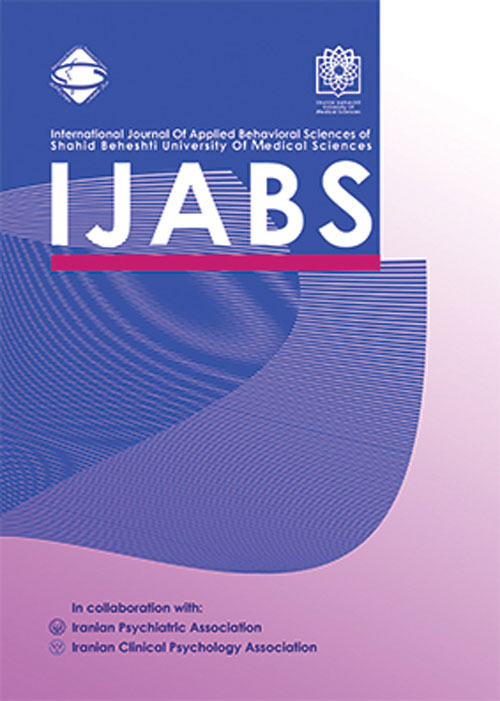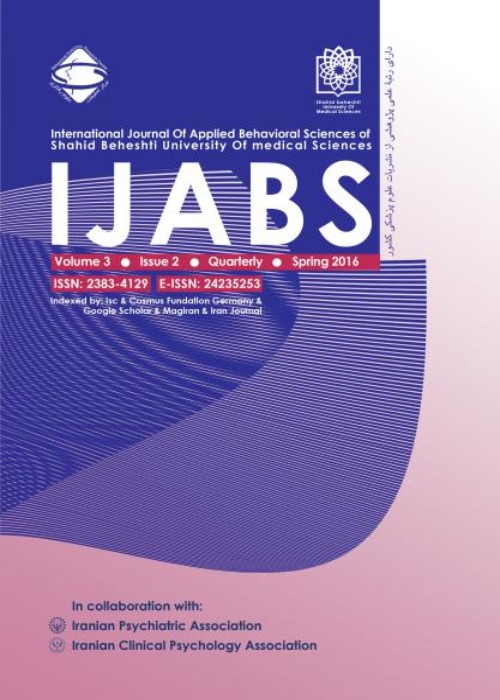فهرست مطالب

International Journal of Applied Behavioral Sciences
Volume:2 Issue: 4, Autumn 2015
- تاریخ انتشار: 1395/01/20
- تعداد عناوین: 7
-
-
Pages 1-10BackgroundThe aim of this study was to elucidate efficacy of transdiagnostic cognitive behavior therapy based on Unified Protocol (UP) for reducing symptoms severity of obsessive compulsive disorder (OCD) with co-occurring anxiety and unipolar mood disorders.Materials And MethodsFrom the thirty patients who participated to treatment, twenty four participants were randomly assigned to receive either immediate or delayed treatment. All participants were assessed using both clinician-rated and self-report measures. The immediate or intervention group were received 20 sessions taking one hour TCBT intervention based on UP but delayed group did not receive any intervention. After gathering the data from two groups, the UP was implemented for delayed or control group. Three regular assessment administrated that consisted of pretest, posttest, and a month follow-up (FU).ResultsThe UP afforded a very strong effect on diagnostic severity, obsessive compulsive frequency of symptoms, dimensions and total functioning for principal diagnoses from pretreatment to FU. Effect size statistics for assessing treatment gains showed large effects (of 1.49 to 2.64) for heterogonous comorbid disorders that was retained on follow-up. The differences in the proportion of individual achieving responders and high end-state function (HESF) between comorbid diagnoses at post treatment and FU were not statistically significant.ConclusionResults from this study provide additional evidence for the efficacy of the UP in the treatment of OCD with co-occurring anxiety and unipolar depressive disorders, and provide additional support for a transdiagnostic approach to the treatment of emotional disorders.Keywords: TCBT, UP, OCD, Co, occurrence
-
Pages 11-17IntroductionDifferences in emotional control and social skills appear to partially reflect differences in longstanding intrapersonal qualities, such as temperament, but parenting characteristics also have emerged as indicators of how children develop emotional and social competence.MethodsThe study design was correlational. Sample was 60 children in age preschool (30 boys and 30 girls) and their mothers (60 females) selected using convenience sampling among children were registered for preschool in a private school. Instruments were used in this study include: Coping with Childrens Negative Emotions Scale (CCNES), Behaviour Rating Inventory of Executive Functioning (BRIEF), Social Skills Rating System (SSRS). Data analyzed using simple regression and structural equation modeling (SEM).ResultsData analysis showed that childrens emotion regulation skills predicted their social skill levels (F=69.98, p=0.0001) and Total maternal emotion socialization predicted childrens emotion regulation (F=98.15, p=0.0001) and childrens social skills (F=39.45, p=0.0001). Other result was childrens emotion regulation skills completely mediated relation between reactions to childrens negative emotions and childrens social skills.ConclusionsThis research highlighted the important impact of emotion-related parenting behaviours and beliefs on childrens development of social and emotional competence.Keywords: Maternal Reactions to Children's Negative Emotions, Children's Social Skills, Emotion Regulation
-
Pages 18-22IntroductionThe aim of the present research was to study the psychological rehabilitation impact through Dohsa-Hou on motional performance and peer relationship self-efficacy of children suffering from ADHD at Zahedan City.MethodsThe research is semi-experimental including pre-test, post-test and follow-up in two experiment and control groups. The research statistical population includes all children suffering from ADHD. 30 children 7-9 suffering from ADHD was selected through sampling. 15 children were assigned in control group and 15 children were assigned in experiment group randomly. Furthermore, another assessment was conducted through post-test and follow-up at the end. Dohsa-Hou treatment duration was 12 sessions in experiment group (3 sessions per week) and follow-up was conducted one week after the post-test. Data resulted from questionnaire were analyzed using SPSS-19 software and descriptive and inferential tests.ResultsThe results of analysis MANCOVA showed that psychological rehabilitation through Dohsa-Hou method has caused to increased motional performance and self-efficiency promotion of children suffering from (ADHD) in relationship with their peers (P≤0.01).ConclusionDohsa-Hou method is an effective treatment for promotion of their motional performance and self-efficiency in relationship with their peers.
Declaration of Interest: NoneKeywords: Rehabilitation, Self, Efficiency, Peers, ADHD -
Pages 23-32BackgroundSeveral studies have shown that Attentional Bias plays a role in the beginning, persistence and relapse of Substance Abuse Disorder. Therefore, identifying the factors related to Attentional Bias in Substance Abusers is important. In so doing, the present study was aimed at examining the relationship between attentional bias, Anxiety Sensitivity and Metacognitive Beliefs in Substance Abusers with an emphasis on mediating effects of Emotion Regulation Strategies.MethodsThe present study is fundamental in terms of the objective and descriptive regarding data collection which was conducted within the framework of a correlation study. The statistical universe comprised a group of soldiers in Tehran who were considered as Substance Abusers and had been referred to Addiction Treatment Centers of Baharestan County. Among the statistical universe, 120 participants were selected by non-random purposive sampling. Finally, Anxiety Sensitivity, Metacognitive Beliefs, Emotional Regulation Strategies and the Stroop test questionnaires were conducted on the sample. For sorting, processing and analysis of data and the evaluation of the research hypothesis, we used the SPSS and LISREL. To examine the relationship between variables, the Pearson correlation and path analysis were used.ResultsPearson correlation results indicated that Anxiety Sensitivity, Metacognitive Beliefs, Suppression, and Reappraisal have a significant relationship with the Attentional Bias.The results of the path analysis revealed that the direct effect of Anxiety Sensitivity and Metacognitive Beliefs on the Attentional Bias is not significant, but these structures may have an effect on the Attentional Bias only through the mediator variables (Suppression and Reappraisal).ConclusionAn individual resorts to metacognitive beliefs to get rid of the negative emotions caused by high Anxiety Sensitivitybut these emotions get intensified in this process and the individual in the long term experiences Substance Abuse through avoidance strategies such as Suppression.Therefore, whenthe personexperiences negative emotions, he will have an Attentional Bias toward liberating signs of Substance Abuse inside and outside.Keywords: Attentional Bias, Anxiety Sensitivity, Emotion Regulation, Metacognitive Beliefs, Reappraisal, Substance Abuse Disorder, Suppression
-
Pages 33-38Background And ObjectivePsychological aspects of chronic diseases has attracted many professionals. Because the incidence of sudden and uncontrollable symptoms of many diseases, causing stress and create a variety of negative emotions and mood in patients'. The purpose of this study was to investigate the effectiveness of group reality therapy in reduceing stress, anxiety and depression in patients with multiple sclerosis (MS).MethodThis study is semi-experimental with pretest-post test and control group. The Research community included all MS patients referred to MS Society of iran in tehran. That was the beginning of the DASS-21 questionnaire. Among those who score high on this scale had a mean of 40 was selected and Randomly divided and assigned into two experimental and control groups (N=20 subjects) and matched control group (20 subjects) were replaced by the two groups. Both group were tested in the pre-test and post-test. The data of pre-test and post-test were analyzed using descriptive and inferential statistics (analysis of covariance).
Findings: Findings showed a significant reduction in the mean of the three variables of stress (F(1,38)= 81.37 ; PConclusionin this study group reality therapy significantly reduces stress, anxiety and depression in the intervention group compared with the control group . The reality therapy can be effective therapy in the treatment of stress, anxiety and depression in patients with MS and as an adjunct to other therapies.Keywords: reality therapy, stress, anxiety, depression, multiple sclerosis -
Pages 39-42IntroductionOnline Medicare is a method in which parts of a medical process, whether its diagnostics, monitoring or the treatment itself will be completed by using online services. At the first step the students were registered for using the system. They participated in estimating depression scale; anxiety scale and clinical interview by online medical care system. Subsequently, the lab examination tests were performed on persons specified by the system.
The lab examinations include: serum level of vitamin D3&4, serum level of vitamin B125&6, fasting blood sugar7&8, HbA1c7&8, thyroid function test9&10 and CBC. All of the students were solely treated by vitamins or minerals therapy and/or treatment of medical problems (such as hypothyroidism).MethodsFor detecting the role of socioeconomic welfare in the prevalence of the diseases, we implement the system in a low middle class boys state high school, and in an above average boys state high school and in an above average boys private high school. The prevalence of severe vitamin D deficiency, hypoglycemia, impaired fasting glucose level and vitamin B12 deficiency were compared in students who lay in different socioeconomic situation.ResultsSevere vitamin D deficiency is significantly higher in above average neighborhoods than low middle class neighborhoods with p value = 0.024ConclusionIn Karaj, Iran, in societies with better socioeconomic situation, we can find higher severe vitamin D deficiency, it can be due to urbanization, living in apartment, over protection, preferring indoor games to outdoor games. Declaration of Interest: None.Keywords: Depression_Anxiety_Vitamin D Deficiency_Socioeconomic -
Pages 43-48BackgroundBorderline personality disorder (BPD) is a chronic condition that warrants further empirical investigation. The aim of this research was investigated prediction of BPD symptomatology relay on recent life experience.
Method and Materials: Data for the current study was collected from students of Shiraz university. Sample consisted of 120 undergraduate students. The ages of the sample ranged from 18-26 with an average age of 19.55. Forty-four participants were men (36.6%) and fifty-six participants were women (46.6%). Instruments were used in this study include: Inventory of College Students Recent Life Experience (ICSRLE; Kohn, Lafreniere, & Gurevich, 1990) and Five-Factor Borderline Personality Inventory (FFBI; Mullins-Sweatt et al., 2012).Resultsrevealed non-significant effects for gender on total borderline personality scores, five subscales of FFBI and negative life events. Also these results showed negative life events predicted borderline personality traits.ConclusionNegative life events could predict borderline personality traits.Keywords: Borderline Personality Disorder, Negative Life Events, Students of University


